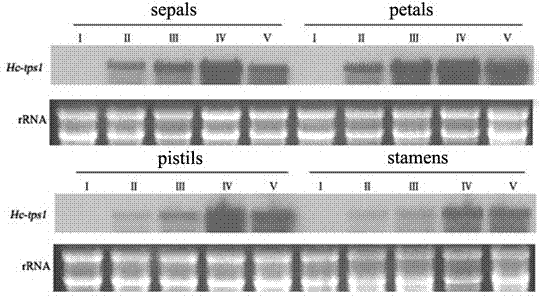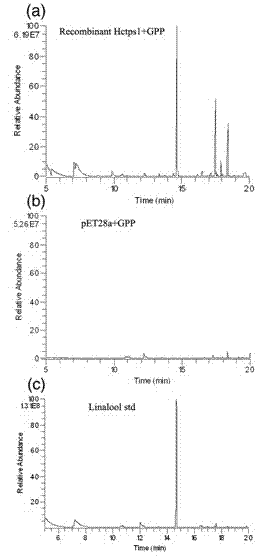Terpene fragrance gene Hctps1 from hedychium coronarium and use thereof
A technology of terpenoids and genes, which is applied to the ginger flower terpenoid floral fragrance gene Hctps1 and its application field, can solve the problem of not finding common structural elements, etc., and achieve the effect of shortening the breeding time
- Summary
- Abstract
- Description
- Claims
- Application Information
AI Technical Summary
Problems solved by technology
Method used
Image
Examples
Embodiment 1
[0029] Example 1 Hctps1 Acquisition of gene cNDA and full-length DNA:
[0030] Ginger flower material: The ginger flower uses the petals of white ginger flower in full bloom. Weigh about 10g of the sample in a mortar, grind it into a powder with liquid nitrogen quick-freezing, and then transfer it to a sterile 50 mL centrifuge tube; immediately add 20 mL of boric acid buffer solution preheated at 80°C, incubate at 42°C and extract with slight shaking for 2 hours ; add 1 / 3 volume of 2.4 mol / L KCl solution and place in ice bath at 4°C for more than 1 h; centrifuge at 20,000 rpm and 4°C for 30 min; take the supernatant and add 8 mol / L LiCl solution to make the final concentration of LiCl become 2 mol / L, precipitate RNA overnight in ice bath at 4°C; centrifuge at 10,000 rpm for 30 min and remove the supernatant; wash the precipitate with 2 mol / L LiCl solution 1-3 times; add 10 mmol / L Tris-HCl (pH7.5) Buffer solution to dissolve the precipitate; add 2mol / L KOAc solution and mix o...
Embodiment 2
[0041] Example 2 Hctps1 Gene expression analysis:
[0042] Take 1 μL of the total RNA solution and dilute it 100 times, measure its concentration on the Eppendorf Biophotometer Nucleic Acid Protein Analyzer, calculate the volume of RNA solution used to take 10 μg RNA, make up to 10 μL with sterilized ultrapure water, add 10 μL EB-containing RNA electrophoresis and load the sample The buffer was denatured at 70°C for 10 minutes, cooled rapidly in ice, and subjected to denaturing gel electrophoresis (50V, 60min) with 1.2% agarose gel containing formaldehyde. After electrophoresis, observe whether the bands are consistent in depth under the gel imaging system. If they are inconsistent, adjust the amount of total RNA loaded. After adjusting the total RNA bands to be basically consistent, put the gel pieces in a 2×SSC solution, shake and wash twice on a decolorizing shaker at room temperature, about 20 minutes each time. The denatured RNA was transferred from the gel to a nylon m...
Embodiment 3
[0048] Example 3 Hctps1 Gene prokaryotic expression:
[0049] According to the obtained full-length cDNA, the signal peptide fragment was removed, and the S alI and N otI restriction site-specific primers for PCR amplification. The PCR product was recovered with the Takara recovery kit, and the recovered product was directly used S alI and N otI restriction endonuclease was used for double digestion, and 1% agarose gel was used to recover the target fragment. For pET-28a prokaryotic expression vector S alI and N otI restriction enzyme was used for double digestion and 1% agarose gel was used to recover large fragments. After ligation overnight at 16°C, the ligation product was transformed into Escherichia coli ( E. coli ) DH5α competent cells; the recombinant prokaryotic expression vector was obtained after the extracted plasmid was identified by enzyme digestion and sequencing.
[0050] Transform Escherichia coli (BL21) competent cells with the identified recombinan...
PUM
| Property | Measurement | Unit |
|---|---|---|
| molecular weight | aaaaa | aaaaa |
Abstract
Description
Claims
Application Information
 Login to View More
Login to View More - R&D
- Intellectual Property
- Life Sciences
- Materials
- Tech Scout
- Unparalleled Data Quality
- Higher Quality Content
- 60% Fewer Hallucinations
Browse by: Latest US Patents, China's latest patents, Technical Efficacy Thesaurus, Application Domain, Technology Topic, Popular Technical Reports.
© 2025 PatSnap. All rights reserved.Legal|Privacy policy|Modern Slavery Act Transparency Statement|Sitemap|About US| Contact US: help@patsnap.com



